
LIVING PROTOTYPES
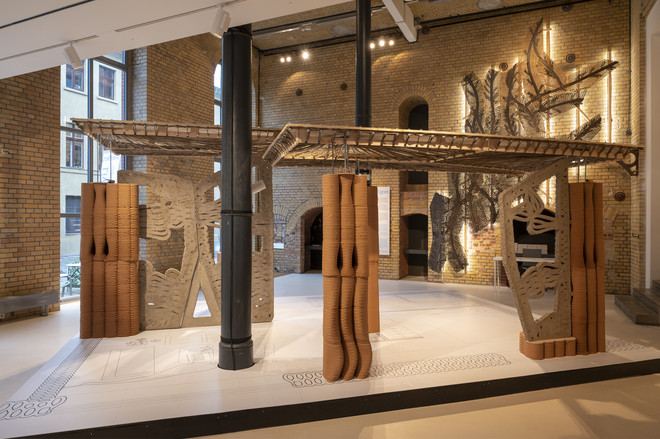
The Living Prototypes research project, was a collaboration between ANCB The Aedes Metropolitan Laboratory in Berlin and three European research teams each comprising an academic and industry partner. The project aim was to conceive, design, manufacture and present resource-efficient prototypes for living spaces, using digital fabrication techniques and biobased materials. By demonstrating real spatial proposals, it was intended that these prototypes would stimulate public interest, and by demonstrating feasibility, would create momentum and build confidence and experience in the construction industry.
The main objective of the Living Prototypes project was to demonstrate and communicate the added value of biomaterials and digital fabrication for architectural practice in terms of design potential and resource-efficient building, by making this tangible and experienceable. The development of the digitally manufactured prototypes took place over a period of one and a half years.
The three research teams worked with the biobased material systems of earth, flax and bioplastics, which are complementary in their sources, properties and potential areas of application in the building sector. The research teams and their projects were:
- 3D-Printed Earth - University Partner: IAAC – Institute for Advanced Architecture of Catalonia, Barcelona. Industry Partner: WASP, Massa Lombarda
- Flax Fibre Winding - University Partner: ITKE – Institute of Building Structures and Structural Design, University of Stuttgart. Industry Partner: FibR GmbH, Kernen
- Bioplastic Prints - University Partner: CITA – Centre for Information Technology and Architecture, Royal Danish Academy, Copenhagen (Research Coordinator).Industry Partner: COBOD International A/S, Copenhagen
The research project concluded in an 6-week exhibition at Aedes Architecture Forum in Berlin from 10.12.2022 - 25.01.2023, in which 1:1 prototypes of living spaces fabricated from biomaterials could be experienced and discussed. As a low-threshold translation of laboratory research, the exhibition of the prototypes aimed to illustrate for the public the potentials of biobased materials and digital manufacturing techniques. The project contributed to the discussion of the transformative changes that the building industry as well as the build environment will need to undergo, when we move into circular building practices with natural materials.

The project achieved this by means of two public workshops that took place in parallel to the development of the prototypes, and a symposium just before the exhibition opening.
The Exhibition and the symposium
In the exhibition, three separate prototypes made of earth, flax fibre and bioplastic, are brought together in a 1:1 scale installation built around a typical floorplan of a 1-bedroom apartment. Contextual and supporting information include visualisations of the architecture possible with these biomaterials and digital fabrication methods, and a selection of sample raw materials, test models and scaled prototypes from further explorations by each research team. Video and photographic material show the development of the biomaterials and building prototypes over the course of the Living Prototypes project.

CITA / COBOD collaboration: Bioplastic Prints
The CITA/ COBOD collaboration focused on bioplastics, which are renewable, inexpensive, biodegradable and chemically diverse. Additive manufacturing and data analysis technologies, such as machine learning, make it possible to predict and control the behaviour of these complex materials during and after the printing process. The biopolymer used in this project is mixed during the printing process. In this way the underlying recipe can be varied on the fly, which allows the adaptation of the properties of the material to local needs (Grading). The CITA – COBOD prototypes for components for interior spaces used two complementary biobased materials (cellulose and collagen). These suggest future circular material life-cycles in buildings that are made possible by this adaptive manufacturing process and the ability to scale up from Lab to architectural component size.
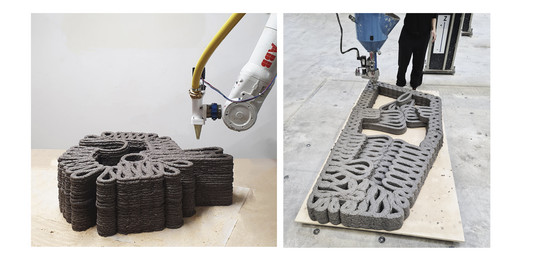
Scaling up of components to architectural scale - Cellulose Screens
The CITA – COBOD subproject Cellulose Enclosures developed and demonstrated strategies to scale up a biopolymer with cellulose from recycled paper to architectural-scale components. This part of the project took place synergistically with the CITA Predictive Response Project
The scaling up of 3D printing processes with the cellulose-based biopolymer – from small-scale robotic printing at CITA to large-scale gantry-based production using a COBOD printer – led to a first full-scale prototype in December 2021, exhibited in Copenhagen (Figure 5). For this, the existing robotic print setup was extended with a new pumping system based on a hopper from the cement industry. This allowed the production of pieces of approximately 70x70x15 cm. Their shrinking behaviour was observed with a monitoring framework. Using machine learning, the data from the observation of the physical probes could be successfully used for the prediction of the biopolymers behaviour.
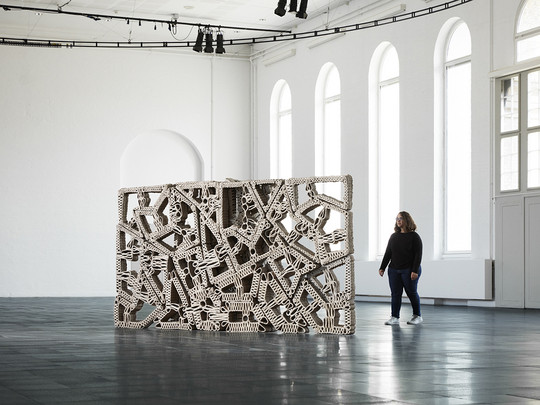
A bottleneck was identified in the curing time of the cellulose/xanthan material used for printing. As this has a water content of approximately 70%, drying by air requires four weeks. This time could be shortened by using energy-intensive kiln drying, but would still be in the range of weeks. The highest reduction of drying time was however achieved in the redesign of the printed element. Instead of printing solid pieces, an undulating print path with internal air channels was developed. In this way the surface area was maximised, good convection could take place inside the printed elements and a unique visual expression was achieved.
In the second phase of the project, the printing of the cellulose/xanthan -based biopolymer was successfully scaled up and tested in what is currently the largest 3D printing system on the market – the COBOD BOD2 542 gantry 3D-printing system - this time in a configuration with a printable area of 12.1 x 9.0 x 3.5 metres. The tests confirmed that 3D printing systems for slurries such as concrete can be used for the cellulose/xanthan-based biopolymer developed by CITA. The material recipe did not have to be adapted for larger-scale printing. Four large screens (max 90 x 250 cm) made of xanthan-based cellulose bioplastic were printed in June 2022 for the Living Prototype 1:1 demonstrator (Figure 6). The initial drying of these four pieces was undertaken inside at the production site with no minimal energy use. Two dehumidifiers ran in a room of 20 sqm with the printed pieces for one month.
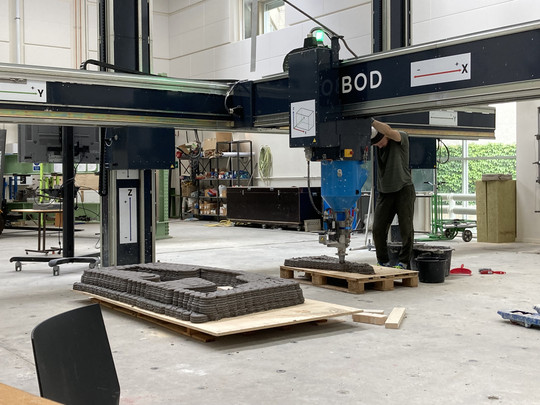

Collagen 3D printed Wall Panels - Radicant
The ability to adapt the recipe of the biopolymer to local requirements was tested with ‘Radicant’ in synergy with the CITA EMA project, the second built demonstrator of 7x5 m, also exhibited in the Living Prototypes exhibition (Figure 8). For Radicant the binder in the original recipe (xanthan) was exchanged with collagen (bone-glue). This resulted in much shorter curing times and opened up the opportunity to develop and demonstrate a material system that can be graded. This move required substantial changes to the print setup: as the bone glue can only be printed at a temperature of 75 degrees, a novel heated robotic 3D printing system and 3D printing logics and protocols for bone glue material had to be developed.
The resulting novel collagen printing process was used for the first time in Radicant - a bespoke wall-panelling system. Here the biopolymer composite was reinforced with various types of cellulose from waste products. Each tile was 3D-printed using a different composition of biopolymer composites, with the resulting variations arranged to create a branching and interwoven form extending over six metres that is materially graded from bottom to top. With a design inspired by the silk tree, the biomaterial tiles are printed more densely where they are fixed at their trunks and become more open towards their leafy edges.
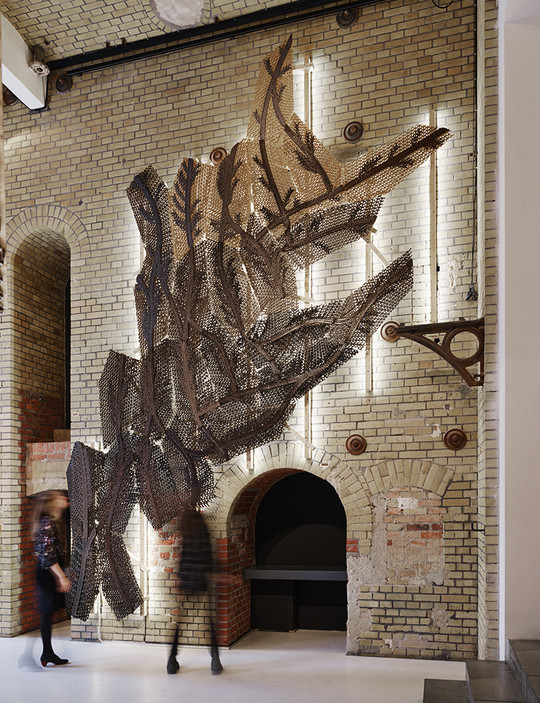
The adaptation of the biopolymer material system and the development of protocols, printing and computational design tools, as well as the design of the piece and its construction system took under five months. While the curing of the collagen mix took only around two weeks, even for 2m large panels, an uneven shrinkage of the elements was observed. The design and fabrication workflow included a feedback loop. For this, a 3D scan of the cured panels was undertaken, to capture any changes or deformations that might have occurred during the drying process. This digitised information was then loaded back into the digital design model, updating it with the detailed geometry of the final panels. In this way, the subsequent fabrication of the wall mounting rails could be based on up-to-date data. Other remaining small deviations of the panels from straight geometries, were taken care of in the design of the mounting system, which allowed for tolerances and adaptation, and by the final assembly process which was guided by the use of a laser projection system.
Publications
- Tamke, M., Chen, Tzu-Ying., Carrasco, O., Ryan, Á., Bouchi, D., Ramsgaard Thomsen, M., Nicholas, P., Dubor, A., Cabay E., Bangsgaard, A., Dörstelmann, M., Naldoni, L., Markopoulou, A., Knippers, J. “Another Logic For Architectural (Bio-) Design and Fabrication - Lessons From The Living Prototypes Project.” In Proceedings for the CEES 2023 Conference, edited by M. Theodoridou Morrow, R., Scott, J., Bridgens, B. Funchal, Portugal: Itecons - Instituto de Investigação e Desenvolvimento Tecnológico para a Construção, Energia, Ambiente e Sustentabilidade, 2023. https://doi.org/10.5281/zenodo.8186841.
- Rossi, G., Chiujdea, R., Hochegger, L., ElHarchi, A., Harding, J., Nicholas, P., Tamke, M., & Ramsgaard Thomsen, M. (2022). Statistically modelling the curing of cellulose-based 3d printed components: Methods for material dataset composition, augmentation and encoding. Design Modelling Symposium Berlin 2022: Towards Radical Regeneration https://doi.org/10.1007/978-3-031-13249-0_39
- Rech, A., Chiujdea, R., Colmo, C., Rossi, G., Nicholas, P., Tamke, M., Thomsen, M. R., & Daugaard, A. E. (2022). Waste-based biopolymer slurry for 3D printing targeting construction elements. Materials Today Communications, 33, [104963]: https://doi.org/10.1016/j.mtcomm.2022.104963
- Rossi G., Ramsgaard Thomsen M. (2022). Cellulose Enclosures: Smart robotic manufacturing for heterogenous biomaterials. in Reindhart D., Loke L., Tillman D. SHERobots tool:toy:companion. ISBN 978-0-6455400-6-2















